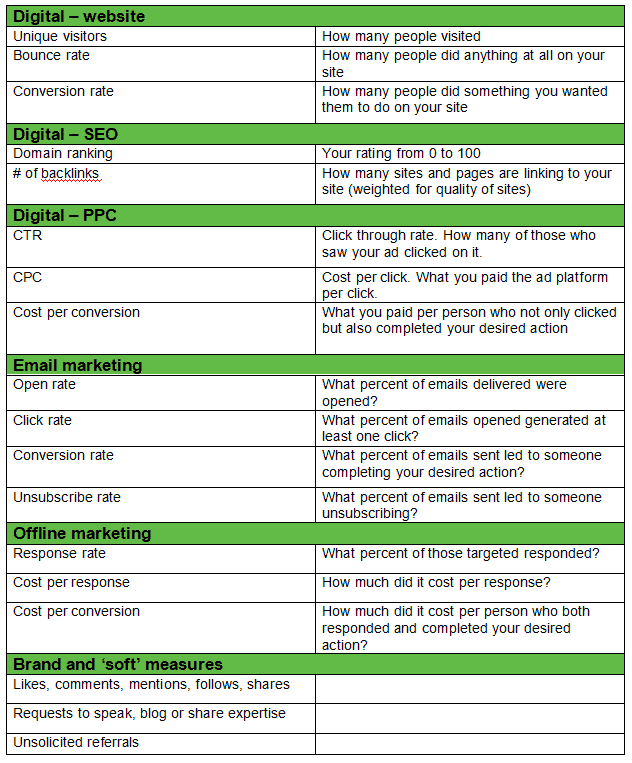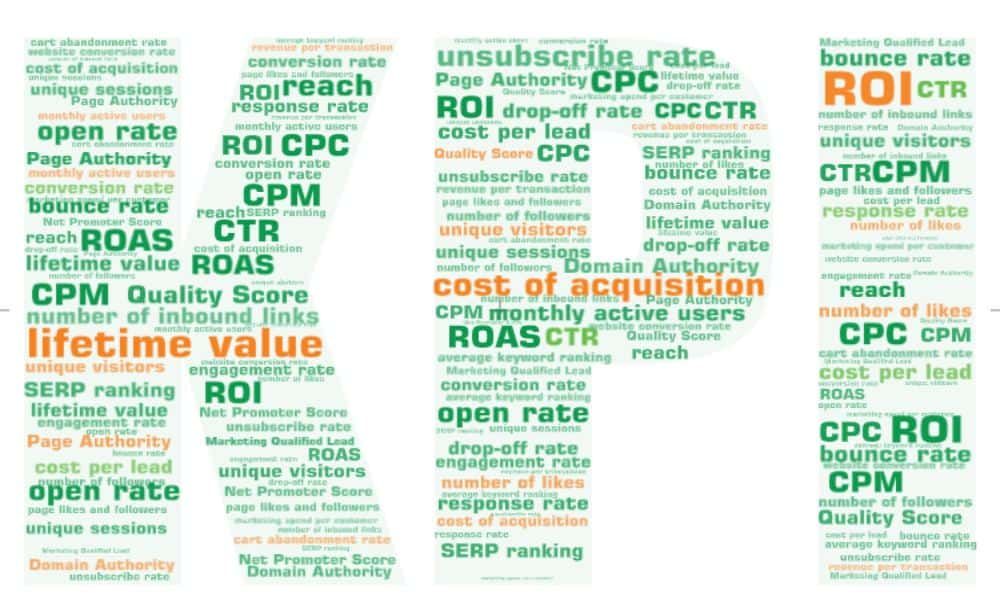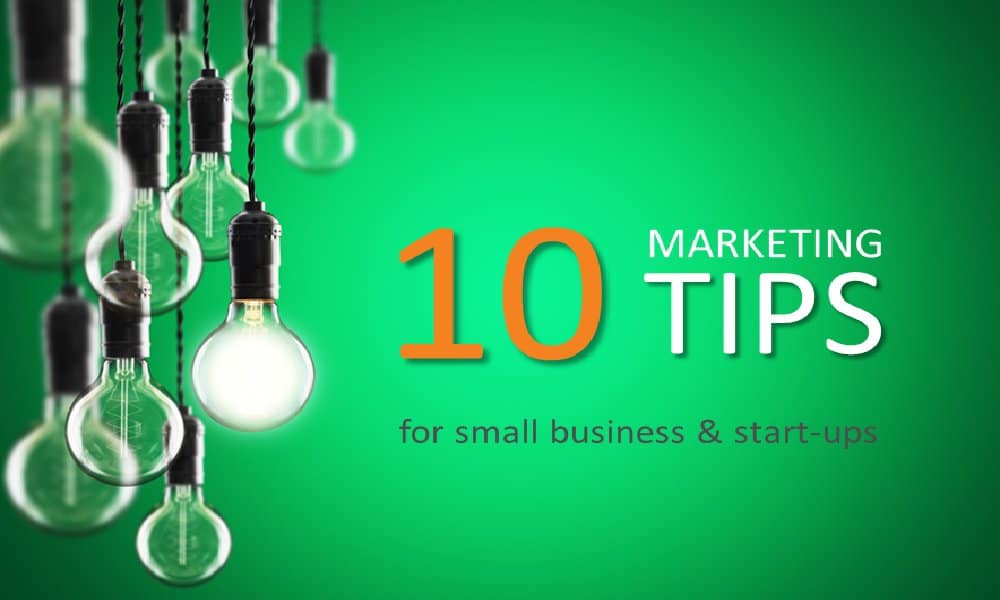If you’re spending money or time on marketing, you need to track how well it’s working. Yet so many small businesses don’t set marketing KPIs, or if they do, they don’t look at them!
If you don’t track KPIs, how can you be sure your marketing is working? And how can you compare channels or campaigns? You need to know what’s working best so you can double down in the future and get even better results.
So what marketing KPIs should your small business track? It needs to be simple and easy, so let’s try to keep to the basics.
Two essential KPIs for your business
There are many many KPIs you could track, but for me two stand out as essential for everyone. They are the cost of acquisition of a new client and the average lifetime value of a client. I already have a whole post about these two essential KPIs. For today, just a reminder that it’s really important to spend less getting a client than you make out of that client!
I’ve divided these in to ways that you can measure performance in different parts of your marketing.
Digital KPIs
In digital marketing, there’s an abundance of data. The challenge is not so much tracking as knowing what to track!
You want your KPIs to track the things which matter to your business. Here are my top suggestions.
Tracking Website Performance
There are some key questions to ask about your website:
- Is anybody visiting my site?
- Are they staying?
- And are they inquiring, or buying? Or do they just disappear never to be seen again?
Fortunately, there are KPIs which answer those questions. And they’re all available in Google Analytics for free. (As long as you set it up correctly.)
1. Is anybody visiting?
That’s the number of unique users, circled in the screenshot below.
2. Are they staying?
Start by checking your bounce rate, also circled in the screenshot below.The bounce rate is the percentage of visitors to your website who leave without doing anything or clicking at all. Usually a lower bounce rate is better because it means people are staying and interacting.
![]()
Most websites have a bounce rate somewhere between 20 and 60 percent. Blogs often have higher bounce rates, as people read one article they found online or via an email newsletter, then leave.
When you review your bounce rate, don’t just look at the overall rate. Look at how it changes over time. Or compare the bounce rate for different pages. Where the bounce rate is lower, you have content which is drawing people in to interact with your site.
3. Are they enquiring or buying from my site?
Perhaps the most important question. You want website users to do more than just visit. What you want them to do depends on your site and your business. You might want them to buy online. Book an appointment. Complete a contact form. Subscribe to your newsletter. Download a resource. Even watch a video to the end, or complete a survey form, or enter a competition.
In Google Analytics, these desired actions are called Goals. Most are about getting a sale or getting a lead. By definition, they are custom to your site.
Once you have set up your goals you can find them under the ‘Conversions’ tab.
![]()
Most website developers will install Google Analytics for you, but they won’t customise it. So you may not have Goals set up. Or they may be set up wrong. For example, I’ve seen websites where a visit to the contact page is called a conversion success. That’s rubbish. If somebody fills in the contact form and goes to the thank you page that’s a success. They’ve actually completed the form successfully and sent you something.
If you want us to take a look at your Analytics and Goals setup, just ask us. We’ll tell you what you have now at no cost.
Every time someone completes a Goal, that’s a conversion. From one step of the customer journey to the next. Guess what? You also want to track your conversions and your website conversion rate. (That’s the total conversions divided by the total sessions or visits.)
Summing up website KPIs
The basic things that you need to track on your website are all measurable using Google Analytics at no cost to you.
But the key and important steps are:
- set up Google Analytics
- set up your Goals. Get help if you need it.
- test your conversion Goals
- review at least once a month to see whether your website is getting better or worse.
Tracking SEO
You may also be working on SEO to have your website come up in Google search results and get more traffic.
The key measure to see whether your SEO is improving or not are
- your domain authority or domain ranking. This is a score from 0 to 100 calculated by specialist companies like Moz, Ahrefs and Alexa.
- the number of backlinks to your site. This is the number of links from other sites to your site. It means they are quoting and respecting you. Note that more is not always better. A few links from qualified news and government sites will more effective than hundreds of links from low level sites set up as ‘link farms’ with no authority of their own.
SEO is a long and complex process. Keep yourself sane and employ an expert if you want to invest a lot. (We’re not experts, but we can probably recommend someone if it helps!)
If you are going to track yourself, the easiest thing is to download the free Moz SEO toolbar and run it on your own site regularly.
Tracking PPC
You may be doing pay per click digital advertising. Google Ads, Facebook ads, LinkedIn, Instagram or so on. If so, you need to track how your hard earned cash is doing.
![]()
Common and easy to track are:
- the CTR. That is the click through rate – what percentage of people who are shown your ad click on it.
- and the CPC or cost per click. That’s how much it costs you every time somebody clicks on your ad.
But remember, you are not really interested in clicks. The ad platform is interested – they bill you per click, so if you get clicks, they make money. But you don’t make money just because someone clicks. YOu make money when they click and then does something more – a conversion.
So the key metric for you is the cost per conversion.
If that ‘conversion’ generates a lead rather than a customer, you still might not make money. But you have achieved a measurable goal. An enquiry. A subscription. An appointment booking. Whatever it is, it’s something that actually makes a difference to your business. Keep an eye on how much it costs.
Tracking email performance
Email is a foundation of modern marketing, so it’s an important area to track and work on improvements.
The standard measures that pretty much every email program would give you are
- the open rate (what percent opened your email)
- the click rate (what percent clicked on a link in your email)
- the unsubscribe rate.
My word of advice – focus on clicks more than opens. There are two reasons for that.
- It’s possible for software to open an email and deliver an ‘opened’ status even though the reader never actually sees the email. This doesn’t happen with clicks – or at least it’s extremely rare. A couple of spam filters do this – but you can see as they open every single link in every single email. All your social media links, preferences links etc. No (normal) human being would do that!
- Clicks may not be enough to get you a conversion (as discussed above) but they are still better than simply looking at your email.
The only time you need to look at open rates is if they are seriously below average or industry average. This may mean a problem with your email getting to people in the first place. If so, you need to do some work on avoiding spam filters.
By the way, if your email is meant to generate an action, track that! Yes, once again it’s all about conversion rates wherever possible. But note that if you are sending a regular update email, you may not have a desired conversion beyond ‘engage and read the content’.
A note about unsubscribes. You will get them. We all get them. If you’re really smart, you may have a ‘break-up sequence’ for people who aren’t engaging. You’ll still get unsubscribes. Don’t worry, but do monitor. And if the rate is very high, take a long hard look at your list, your segmentation and the frequency and relevance of your mailing.
Tracking performance of offline marketing
Offline marketing is generally much simpler to track. There’s simply less data around. Usually there are only two measures:
- response rate. Did you get any reaction at all?
- conversion rate. Of those who responded, how many did you convert yet another stage on the buyer journey?
This means offline marketing is much easier to compare. You have limited metrics across all campaigns. But it’s harder to optimize if something isn’t working well because you can’t dig into the detail.
Tracking brand awareness, engagement and reputation

Brand awareness, engagement and reputation all come before people respond.
It makes sense. If I’ve heard of you or seen your work (and I don’t hate it), I’m much more likely to reach out and inquire and eventually become a customer. It’s the whole customer journey dating game.
But how do you measure brand awareness, engagement and reputation?
If you’re a big company you invest in market research, either with custom questions or to track things like net promoter score. You pay someone to ask a lot of your clients and prospects about you impartially and anonymously. You might also use social media sentiment tracking so you can look at the words that are used in relation to your brand and social media and see whether there a positive or negative.
All of this is probably a bit out of range for your average small to medium business. So what can you do to try and work out what’s going on?
Some overall website measures are good.
Are you getting a lot of traffic? Dig into it a bit.
- Are visitors coming back? (So you have a big difference between your unique visitors and your unique sessions.)
- Explore deep visits. Someone who viewed three or more pages actually went and explored your site. This is really good for B2B and content rich websites. It may be less relevant if you’re a plumber or you just want somebody to book an emergency plumber.
Look at interaction
On social media this could be likes, follows, shares, comments and discussions.
If you’ve got video on a website or in social media there are options to track whether people watch the video. Aand whether they watch it the whole way through!
Let’s assume you’re building an email list – because everyone should! How many subscribers are you getting each month? Is that number growing? And how many unsubscribes are you getting? If it’s too many, you have a problem.
Look for anecdotal and offline signals
Do you get unsolicited referrals? Meet people who say, ‘Oh yes, I’ve heard about you.’ Find someone asking you to run a seminar or workshop. Get asked to contribute an article or a guest blog post. Find yourself getting PR and press mentions – offline and online!
These are all signs that your message and positioning is getting out there. They’re soft measures and probably hard to measure, but think about what might work with your marketing strategy. If you’re spending a lot on social media, track engagement on those platforms. If you’re committed to content marekting, track your guest blogging / interview / podcast opportunities.
Picking the KPIs for you and your small business
Even this top level listing has come up with around 20 small business marketing KPIs. See the chart below (and you can download for reference too).

My recommendation is that you pick between 5 and 10 and stop there. They should relate to your business and the marketing channels where you are investing the most time and money.
Then make sure you track and review your KPIs religiously, once a month. Set yourself a reminder or get somebody to create a regular report for you.
And remember, it’s not about how they compare to anyone else’s KPIs. It’s about whether you and your business are performing better than you used to.
The sooner you start, the sooner you have a baseline. Why not get going now?







